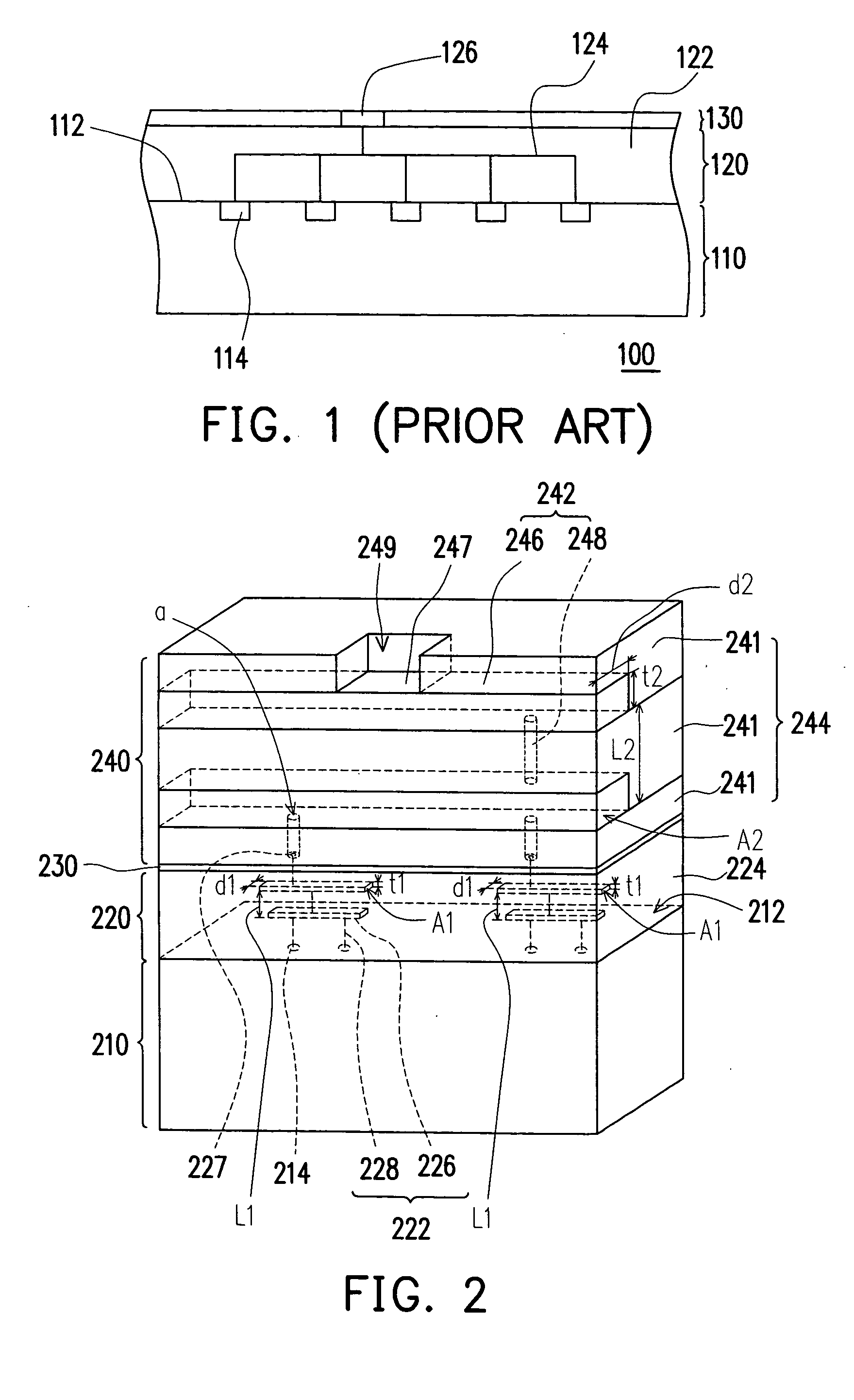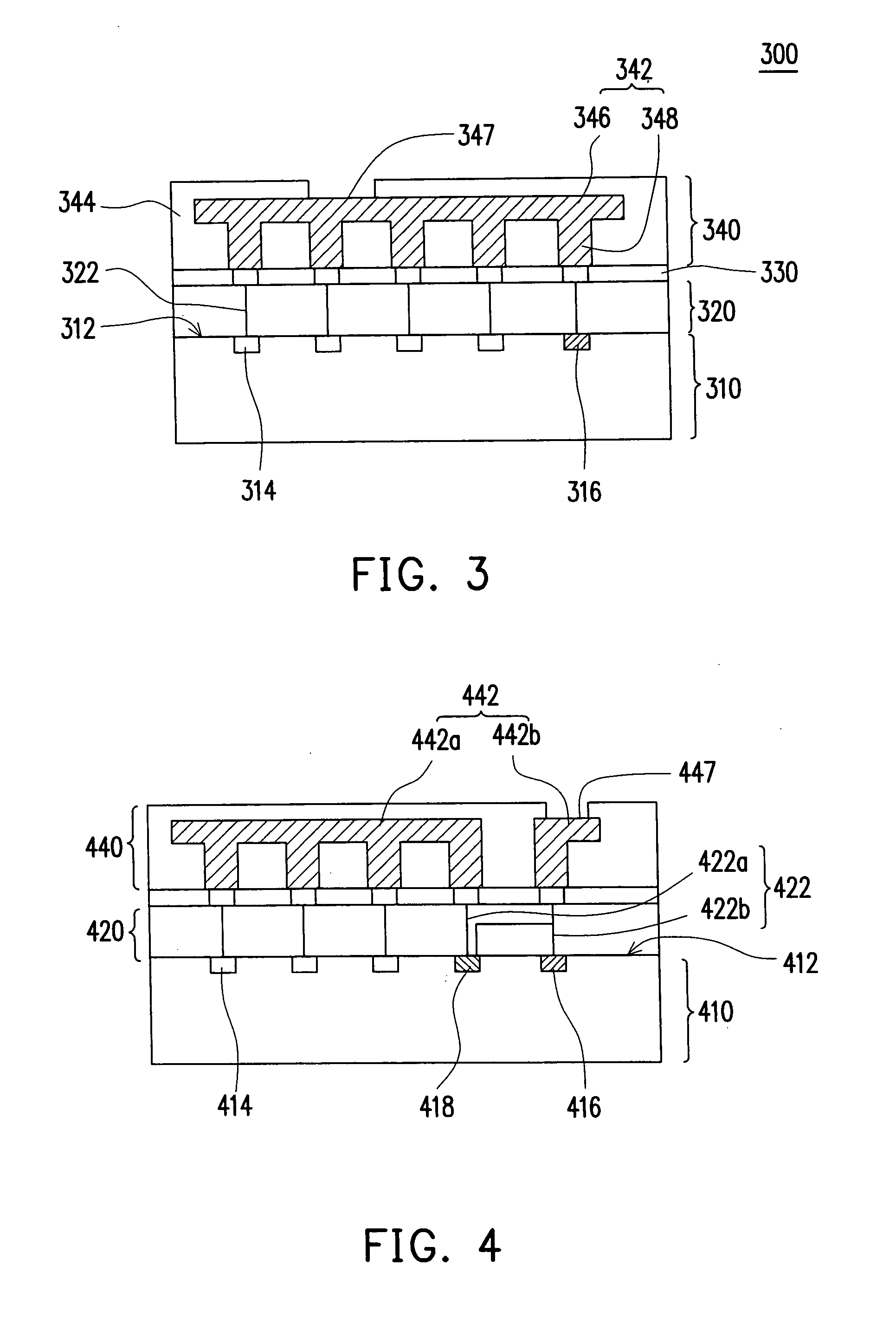Chip structure and process for forming the same
a technology of chip structure and process, applied in the direction of semiconductor devices, semiconductor/solid-state device details, inductance, etc., can solve the problems of noise, resistance-capacitor delay of key traces, voltage drop of buses, etc., to improve resistance-capacitance delay and reduce chip energy loss.
- Summary
- Abstract
- Description
- Claims
- Application Information
AI Technical Summary
Benefits of technology
Problems solved by technology
Method used
Image
Examples
first embodiment
According to the above conception, the present invention provides various improved chip structure. Please refer to FIG. 2, a cross-sectional view schematically showing a chip structure according to the present invention. A chip structure 200 is provided with a substrate 210, a first built-up layer 220, a passivation layer 230 and a second built-up layer 240. There are plenty of electric devices 214, such as transistors, on a surface 212 of the substrate 210, wherein the substrate 210 is made of, for example, silicon. The first built-up layer 220 is located on the substrate 210. The first built-up layer 220 is formed by cross lamination of first metal multi-layers 226 and first dielectric multi-layers. Moreover, plugs 228 connect the upper first metal layers 226 with the lower first metal layers 226 or connect the first metal layers 226 with the electric devices 214. The first metal multi-layers 226 and the plugs 228 compose a first interconnection scheme 222. The first dielectric mu...
second embodiment
Next, other preferred embodiments of the present invention will be introduced. As a lot of electric devices are electrically connected with a power bus and a ground bus, the current through the power bus and the ground bus is relatively large. Therefore, the second interconnection scheme of the second built-up layer can be designed as a power bus or a ground bus, as shown in FIG. 3. FIG. 3 is a cross-sectional view schematically showing a chip structure according to the present invention. The first interconnection scheme 322 of the built-up layer 320 electrically connects the second interconnection scheme 342 of the built-up layer 340 with the electric devices 314 and at least one electrostatic discharge circuit 316, wherein the electrostatic discharge circuit 316 is disposed on the surface 312 of the substrate 310. As a result, provided that the second interconnection scheme 342 is designed as a power bus, the second interconnection scheme 342 electrically connects with the power e...
third embodiment
Referring to FIG. 4, FIG. 4 is a cross-sectional view schematically showing a chip structure according to the present invention. There are many electric devices 414, many electrostatic discharge circuits 416 (only shows one of them) and many transition devices 418 (only shows one of them) on the surface 412 of the substrate 410. The first interconnection scheme 422 is divided into first interconnections 422a and first transition interconnections 422b. The second interconnection scheme 442 is divided into second interconnections 442a and second transition interconnections 442b. Consequently, the nodes 447 are electrically connected with the transition devices 418 and the electrostatic discharge circuits 416 through the first transition interconnections 422b and the second transition interconnections 442b. The transition devices 418 are electrically connected with the electric devices 414 through the first interconnections 422a and the second interconnections 442a. For example, this c...
PUM
 Login to View More
Login to View More Abstract
Description
Claims
Application Information
 Login to View More
Login to View More - R&D
- Intellectual Property
- Life Sciences
- Materials
- Tech Scout
- Unparalleled Data Quality
- Higher Quality Content
- 60% Fewer Hallucinations
Browse by: Latest US Patents, China's latest patents, Technical Efficacy Thesaurus, Application Domain, Technology Topic, Popular Technical Reports.
© 2025 PatSnap. All rights reserved.Legal|Privacy policy|Modern Slavery Act Transparency Statement|Sitemap|About US| Contact US: help@patsnap.com



